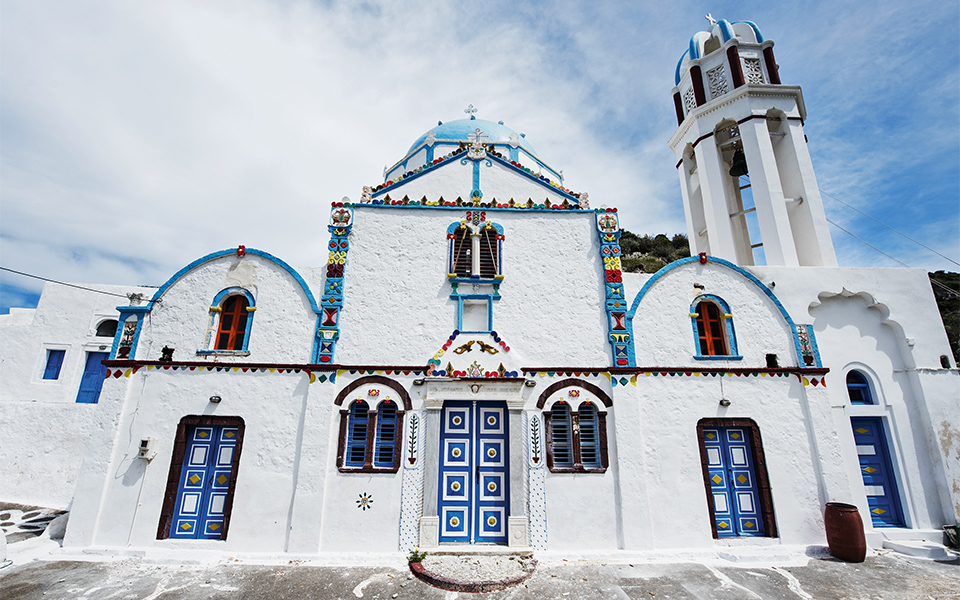It’s like stepping into a time machine. The short boat ride from Ammoudi, the small harbor serving Oia, to the nearby island of Therasia takes you back at least 50 years – to a rural Greece, to a Santorini without tourists. Together with present-day Santorini, this smaller island – variously described as “innocent,” “pristine,” “a wild beauty,” “under-developed” and “off the map” – once formed part of a larger island called Strongyli.
The volcanic eruption of the late 17th c. BC cut Therasia off from the rest of the land mass, showering it with billions of tons of magma that turned into pumice and ash, increasing its surface area to 9.3 square kilometers. At the same time, the caldera was formed – the sea ravine that links, but also separates, Therasia from its larger, cosmopolitan sister.
Even though archaeological research in the Aegean started on Therasia, the island’s history is scarcely known today. Scattered evidence of human activity testifies to its being continuously inhabited from prehistoric times, with human presence shifting locations in order to ensure survival. Historical references to Therasia are few and fragmentary.
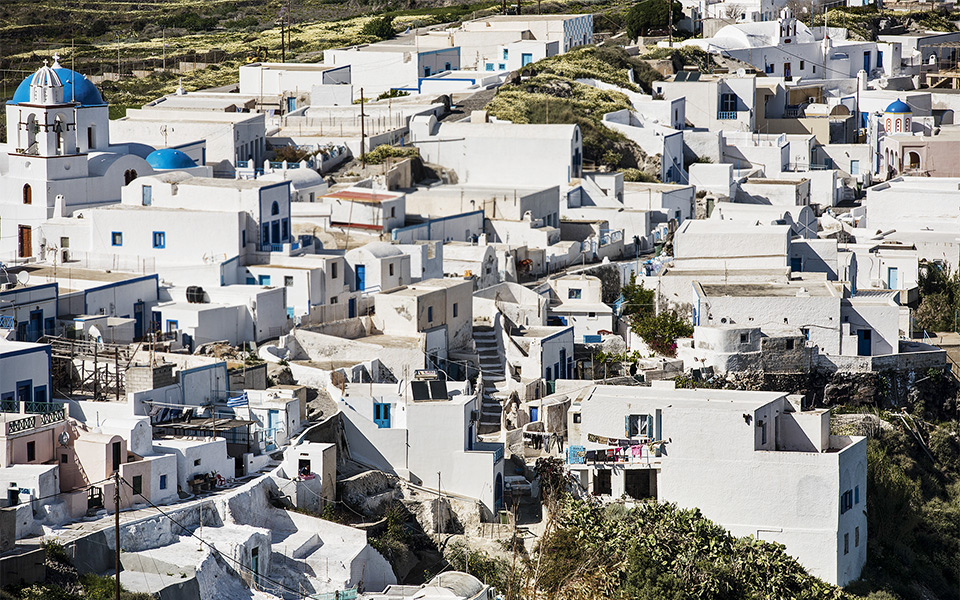
© Vangelis Zavos
Even Herodotus – who devotes eight chapters to Thera, as Santorini was known – ignores Therasia completely. The most plausible explanation is that it was never regarded as a separate entity, but rather as a weak, poorer satellite. This perception applied even in times of prosperity, such as during the Roman era, when it was an important export center for agricultural products.
Over the centuries, the continuous volcanic activity and the way residents reacted to it changed the island. During the 19th century, Therasia became a significant source of pumice, an important building material used in major construction projects such as the Suez Canal and the ports of Trieste and Alexandria.
The winding down of the mining industry and the outbreak of World War II brought about widespread poverty. The island’s two pumice mines, both the “old” one in the south and the “new” one in the north, were abandoned. “My father would come and ask my mother to give us a nudge, to check if we were alive,” recalls an elderly man whom we meet on the road. He makes it very clear though, that despite all the hardship he endured, he never thought of leaving the island he grew up on.
Others, however, have. Its permanent population – which half a century ago numbered 500 – has gradually declined. Men went to find work elsewhere; as miners in Lavrio, Attica (which still has a sizeable Therasian community), as immigrants, mostly to the United States, or as sailors traveling the world. Today, most of these exiles are retired and winter elsewhere, but in the summer they return to their island for some peace and tranquility.
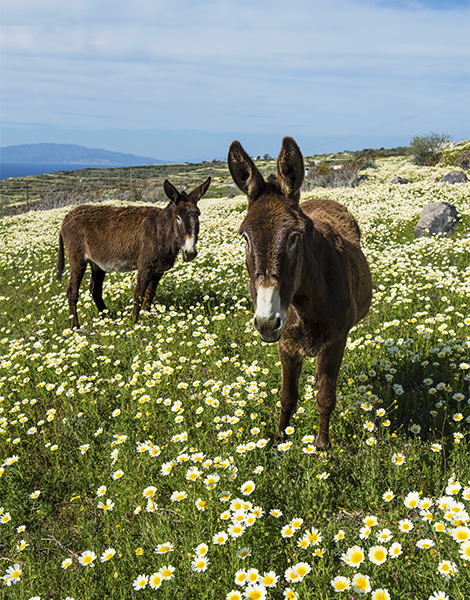
© Vangelis Zavos
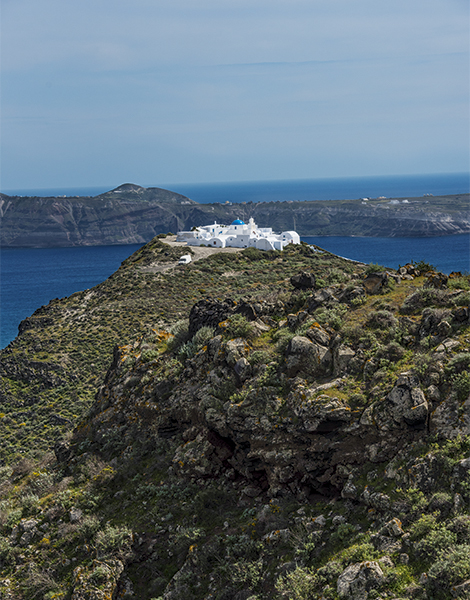
© Vangelis Zavos
“Until the mid-20th century, Santorini and Therasia followed more or less similar paths, as agricultural land lost its value and was slowly abandoned,” explains Clairy Palyvou, Emeritus Professor of Architecture at the Aristotle University of Thessaloniki, who in 2007 undertook the first systematic research of the island’s history, together with Iris Tzachili, Emeritus Professor of Prehistoric Archaeology at the University of Crete. “Since the 1960s, tourism in Santorini has grown by leaps and bounds.
Today it ranks among the most famous vacation destinations worldwide. This sudden change has had sweeping consequences in all areas, cultural and environmental. Therasia did not tag along, though. It stayed behind as if frozen in time. Today, the two islands exist in diametrically opposed circumstances: Santorini has abandoned itself to the frenzy of irrational development while Therasia swings between nostalgia and inertia. It awaits a better future, in which the Santorini model has no place.”
That may be why, on this “little Santorini,” with its 250 permanent residents, electricity didn’t arrive until 1980, why drinkable municipal water (from water tanker ships) was introduced in 1999 and why the first road was not paved until 2008. Therasia now has an ATM, a citizens’ service center, a newly built medical center with a single nurse, but it still lacks a police station, a coffee shop that is open all year round and a barber. There are only a few rooms to let, a handful of tavernas, and a few seasonal shops for the tourists. For all provisions – even for garbage disposal – Therasia is dependent on its “bigger sister,” Santorini, which shines from across the caldera as a separate, bright, clamorous world.
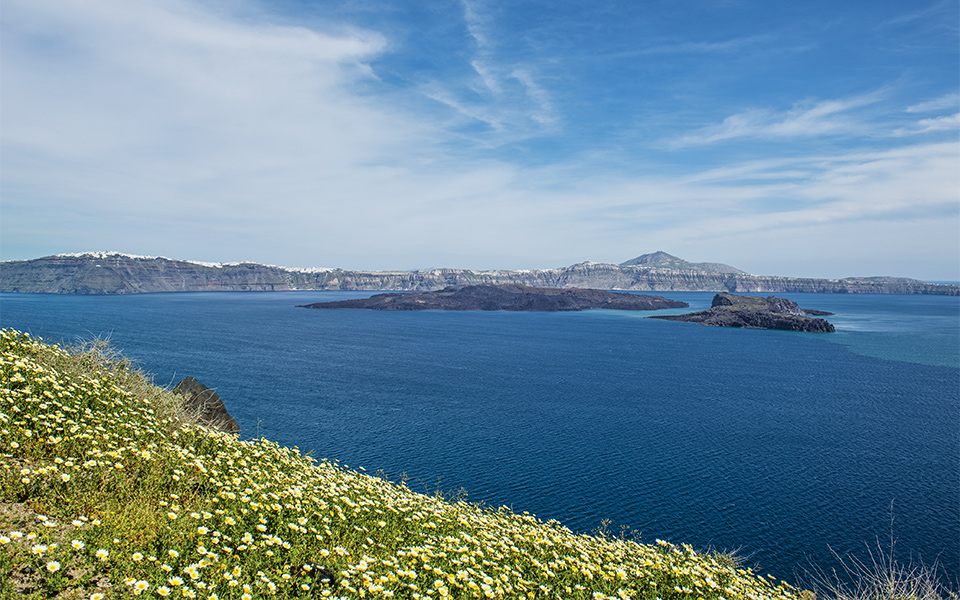
© Vangelis Zavos
“The earth is scorched and arid; the vegetation low, beaten by fierce meltemi winds… A single vine can be seen getting green here and there and the towering agave stalks display their graceful flower clusters. Underground tanks, scattered among the fields and by the sides of the roads, collect precious water, while drystone walls spread out everywhere in the warm, dark, red-gray hues of their volcanic core,” writes Maria Arakadaki, Associate Professor of Architecture at the Aristotle University of Thessaloniki, a participant in the Therasia study.
“Visitors have a strong sense of stepping back in time, to an era when the countryside was used for farming, public transport and water supply systems were not taken for granted and sustainable development (a necessity linked to a bygone cycle of life) was not the latest buzzword in agriculture. The daily pace is slower, a pickup truck retrofitted with benches serves as the taxi, and donkeys – no longer a frequent sight in rural Greece – still play an active part in village life: strong, sturdy donkeys, adorned with beaded and tasseled bridlework, that one can see grazing in the scorching sun along dirt roads.”
EXPLORERS FOR THE DAY
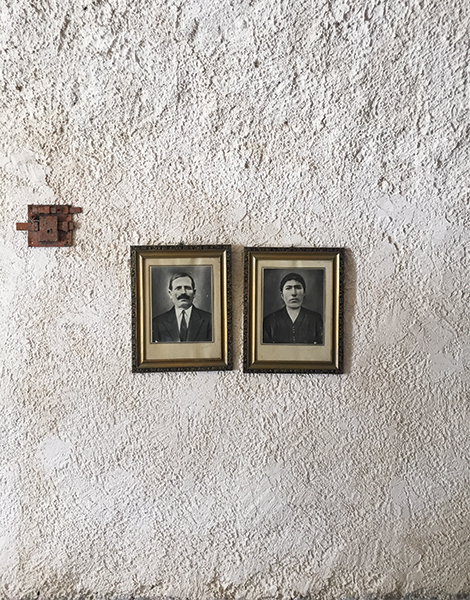
© Giorgos Tsiros

© Giorgos Tsiros
Is it worth interrupting your time on Santorini to get on the boat that services Therasia two or three times a day? Yes it is, because the island is a magical place that offers that rare sense of real discovery. Even more importantly, the discerning traveler will recognize the human achievement behind the taming of this inhospitable land and admire the harmonic adaptation of the community to the natural environment.
Ninety percent of the area is covered by artificial terraces – hundreds of tiny plateaus (on fields, hills or even canyons), all carved out by hand to accommodate human labor and activity. Intricate dry stone walls – up to two meters in height – form and support the terraces. Both elements testify to the ability of the craftsmen of yesteryear and to the special relationship that the islanders have with their land.
Dry stone walls and terraces were not a means to prosperity – purely one of survival. Creating arable land was a necessity for people who had to provide for their basic needs. At the same time, it was also a way of preserving invaluable rainwater. Taking advantage of the island’s morphology, the farmers here managed to build an intelligent irrigation system that gathered the free-flowing water from torrents, channeling it to wherever it was needed. Furthermore, dry stone walls lined the island’s road network as well, a network which provided the locals with access to their arable land.
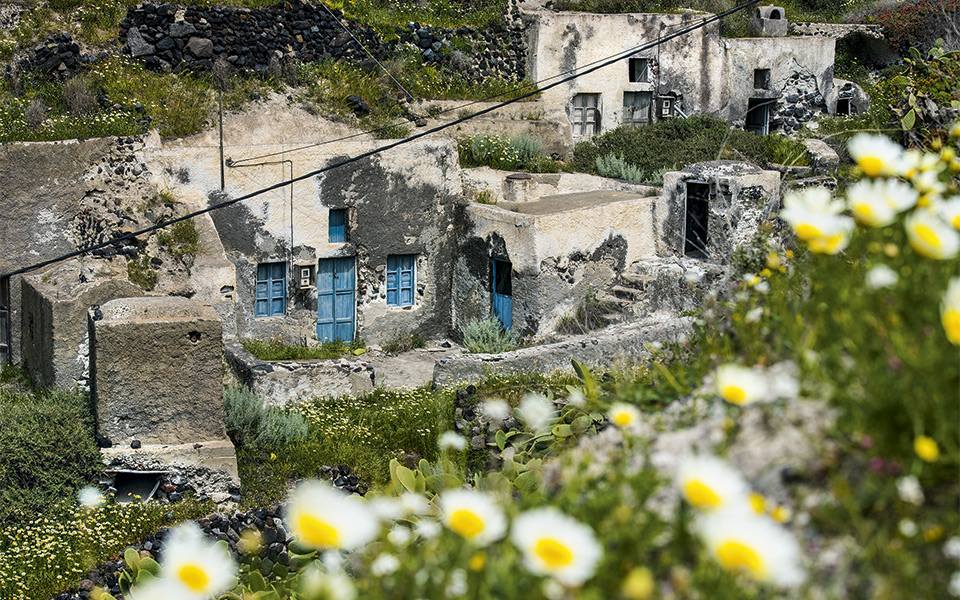
© Vangelis Zavos
The overall unity between the manmade and the natural highlights the skill of these early craftsmen: their work has stood the test of time. Unfortunately, the land they worked so hard to tame is no longer farmed, due to the difficult conditions, declining numbers of young people, dwindling prospects and an abundance of wild rabbits. Introduced at some point to provide game for hunters, these animals multiplied at an uncontrollable rate and now wreak havoc on crops.
Despite all this, for those keen on walking, Therasia is still a gem. Once you step off the small boat that drops visitors off at Riva – the harbor across from Oia – you’ve come too far not to visit the two village communities on the island. Manolas, the larger one, developed in a line along the ridge of the caldera in the 19th century, mirroring Fira, Imerovigli and Oia on Santorini. Manolas also boasts Panorama – a taverna that lives up to its name with first-class views across the caldera. The village is linked, through a series of cobbled steps, to a small harbor below, Korfos, where the only tourist shops on the island are to be found.
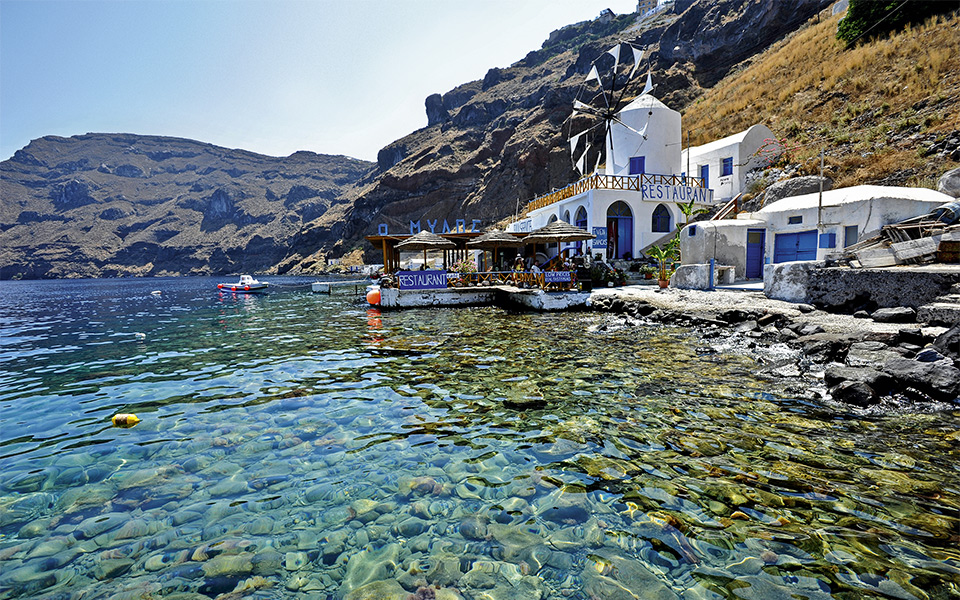
© VisualHellas.gr
The other community is Potamos, where many of the homes are carved into the rock: built within a canyon, it remains an active spot even in winter. Near Potamos is Agrilia, an otherwordly and almost deserted farming village, where only a few of the original 130 houses remain occupied. The settlement was carved out of the sides of a dry gulch, on three different levels. The most sought-after and best-built houses were on the lowest level, close to the communal path. Over this landscape stands the Church of the Presentation of the Virgin Mary (1887), generally considered one of the most beautiful in the Cyclades.
For the intrepid at heart, a unique hiking experience is the path leading from Manolas to the weather-beaten chapel of Profitis Ilias, then on to Kera – a tiny, now deserted, community of buildings carved into the rock that overlooks the sea – and continuing south to the Cape of Trypiti where you’ll find the Monastery of the Dormition of the Virgin Mary. The breathtaking view will make you feel like you’ve reached the end of the world.
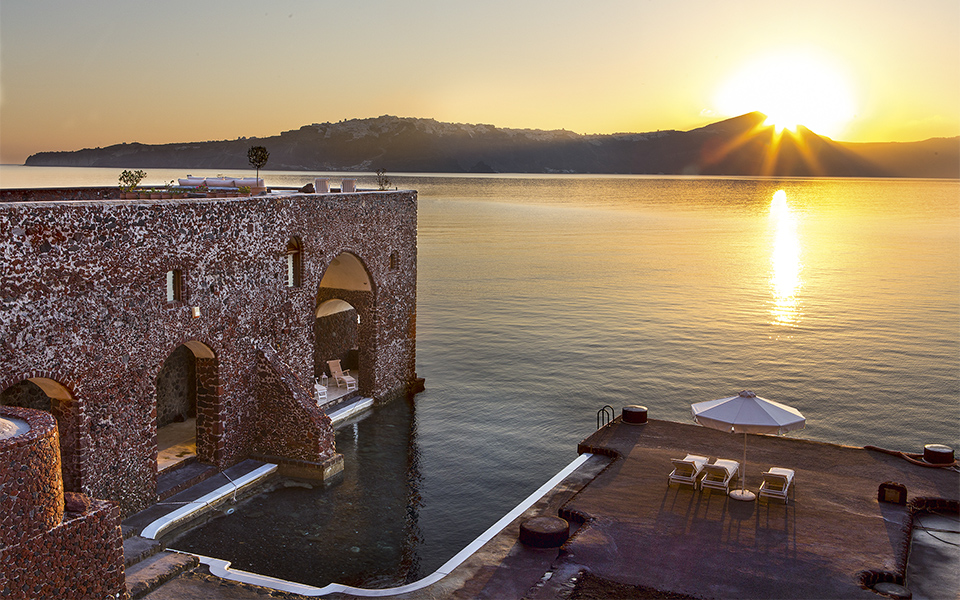
© Enrique Menossi / Perivolas Hideaway
“We invite visitors to Santorini to come here, too, and discover something different,” says Dimitris Syrigos, president of the local community and a man who, despite his profound love for his island, spent half his life on ships. It’s ships that help keep Therasia alive, too. Every summer the locals who work in tourism prepare for the daily arrival of boats with visitors who alight, see what there is to see – perhaps enjoying a meal – but then, because of a lack of any real infrastructure, leave on the same day.
This unspoilt island could certainly claim a greater share of the tourism market by following its own course of development and embracing the discerning and wealthy. The first serious investment in this direction was made two years ago, when Therasia saw the opening of Perivolas Hideaway, an offshoot of one of Oia’s most emblematic resorts. A diving center and luxury lodge, the Hideaway has just four super -luxurious suites near the site of the old mines.
The recipient of a European architectural award, it is reachable only by sea or air (it has a heliport), and is so perfectly integrated into the landscape as to be practically invisible. No wonder it served as the chosen hideaway of Angelina Jolie and Brad Pitt when they were still Hollywood’s golden couple. Most locals, however, have never actually set eyes on it.

